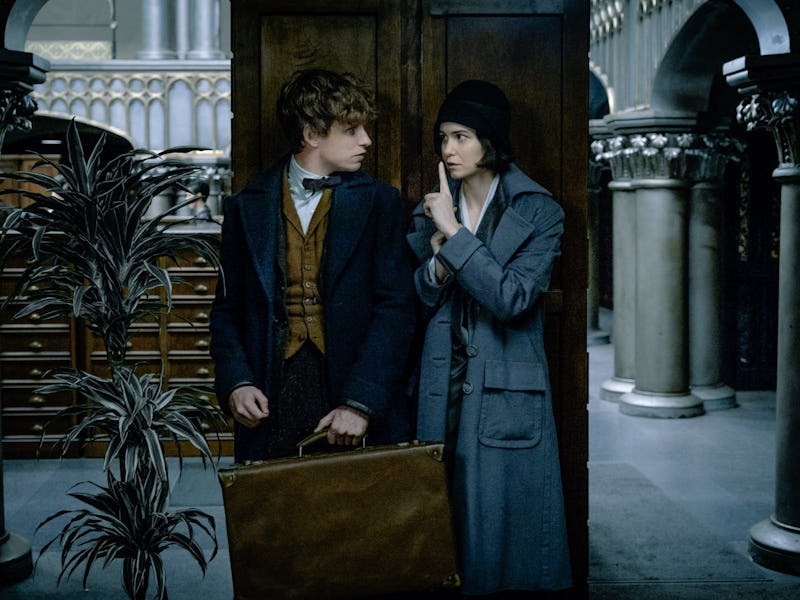All the 'Harry Potter' Easter Eggs in 'Fantastic Beasts'
From the Deathly Hallows to the Lestranges, here's a guide for the references to note.

The Harry Potter spin-off Fantastic Beasts and Where to Find Them is its own animal with a new location, time period, and cultural variations from the original. Nevertheless, it still is very much a Potterverse story. Just as Hogwarts will always help those who ask for it, Fantastic Beasts will provide Potter nods to those who look for them. Not all of them are immediately obvious, but here is a spoiler-free guide to the areas you should pay constant vigilance to.
Innocuous references
Nifflers
The first fantastic beast we see is a niffler. While viewers don’t need to have taken Care of Magical Creatures to understand what’s happening — it’s immediately self-explanatory that they love shiny objects — Potter fans might remember nifflers from Order of the Phoenix. There is a memorable reference after Fred and George dramatically quit school and their friend Lee Jordan puts one in Umbridge’s office.
Quidditch
In the film’s opening montage of newspaper headlines, one reads “Is soccer the No-Maj Quidditch?” Later, when Eddie Redmayne’s Newt Scamander stumbles upon a wizard hate-group, their leader asks if he is a “Seeker.” He responds with a Quidditch joke, “I’m more of a Chaser, really.”
While these nods are fun, they aren’t crucial to the plot if you miss them.
Middle of the road references
School rivalries
In Goblet of Fire, our Hogwarts-centric viewpoint expands as we meet students from French school Beauxbatons and Bulgarian school Durmstrang. Fleur Delacour turns her nose up at Hogwarts’s lackluster ways, making a rather haughty first impression. Similarly, in Fantastic Beasts, when the subject of school comes up, sisters Tina and Queenie Goldstein champion the American school Ilvermorny as the best and call Hogwarts “Hogwash.” It seems that no matter the time period, school superiority endures.
The Hog’s Head
Seedy Hogsmeade haunt The Hog’s Head — which we first see in Order of the Phoenix when Dumbledore’s Army meets there, and then in Deathly Hallows, when it plays an important role in the Battle of Hogwarts — is not directly referenced in Fantastic Beasts. However, Newt and his friends attend a Wizard speakeasy called The Blind Pig with a similar vibe, making it a visual nod.
While these nods are not crucial to the first film, both could easily play a role in the franchise’s four future installments.
Very important references
Dumbledore
Dumbledore is mentioned in conjunction with Newt Scamander’s expulsion from Hogwarts, which has a similar circumstance to Hagrid’s. Recall that Hagrid was expelled for endangering fellow students by way of his love for the acromantula Aragog. Like he did with Hagrid, Dumbledore apparently took an interest in Newt and tried to plead his case. As we know that he will appear in future installments, even this minor reference is crucial.
The name Lestrange
Bellatrix Lestrange is arguably one of the most dangerous characters in the wizarding world. She’s more prone to violence than Umbridge, who prefers to have others do her dirty work. Even Voldemort lies low in Albanian forests when he sees that his odds of survival are low. But Bellatrix has no survival instinct — she’s eager to die for her Dark Lord, and when she’s backed into a corner, she tortures and murders.
When the name Lestrange is mentioned in Beasts, your ears can’t help but perk up. Even if it’s just Bellatrix’s ancestor-in-law, this reference is of the utmost importance.
The Deathly Hallows
Because the Deathly Hallows are on the cover of the final Potter book, most fans probably remember them. But between the the confusion with wand lore and the Tale of the Three Brothers, you might have forgotten that the Deathly Hallows have two meanings. A quick refresher: The Hallows consist of the Elder Wand, the Resurrection Stone, and the Cloak of Invisibility. To possess all three makes one a Master of Death, which is a desirable goal if you want eternal life but don’t want to bother with that messy Horcrux business. However, aside from the whimsical quest for non-violent eternal life, the triangular Hallows symbol has also been appropriated by the Dark wizard Gellert Grindelwald, Dumbledore’s former friend and love interest.
“For the greater good”
This was Grindelwald’s slogan, and his justification for his evil deeds. Killing Muggles was fine, because it was “for the greater good.” When somebody says these words at the height of Grindelwald’s power, your Extendible Ears should perk up.
Fantastic Beasts hits theaters on November 18.